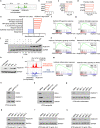A local tumor microenvironment acquired super-enhancer induces an oncogenic driver in colorectal carcinoma
- PMID: 36253360
- PMCID: PMC9576746
- DOI: 10.1038/s41467-022-33377-8
A local tumor microenvironment acquired super-enhancer induces an oncogenic driver in colorectal carcinoma
Erratum in
-
Author Correction: A local tumor microenvironment acquired super-enhancer induces an oncogenic driver in colorectal carcinoma.Nat Commun. 2023 Apr 6;14(1):1923. doi: 10.1038/s41467-023-37640-4. Nat Commun. 2023. PMID: 37024505 Free PMC article. No abstract available.
Abstract
Tumors exhibit enhancer reprogramming compared to normal tissue. The etiology is largely attributed to cell-intrinsic genomic alterations. Here, using freshly resected primary CRC tumors and patient-matched adjacent normal colon, we find divergent epigenetic landscapes between CRC tumors and cell lines. Intriguingly, this phenomenon extends to highly recurrent aberrant super-enhancers gained in CRC over normal. We find one such super-enhancer activated in epithelial cancer cells due to surrounding inflammation in the tumor microenvironment. We restore this super-enhancer and its expressed gene, PDZK1IP1, following treatment with cytokines or xenotransplantation into nude mice, thus demonstrating cell-extrinsic etiology. We demonstrate mechanistically that PDZK1IP1 enhances the reductive capacity CRC cancer cells via the pentose phosphate pathway. We show this activation enables efficient growth under oxidative conditions, challenging the previous notion that PDZK1IP1 acts as a tumor suppressor in CRC. Collectively, these observations highlight the significance of epigenomic profiling on primary specimens.
© 2022. The Author(s).
Conflict of interest statement
R.E.P. owns equity in Therapten. Ramon Parsons receives royalty payments from Cullgen and Therapten. R.E.P. gives industry-sponsored lectures at the Lurie Cancer Center and the University of Southern California Cancer Center. R.E.P. reports other activities with Columbia University and Regeneron Pharmaceuticals. S.H.I. consults for EXACT Sciences Corporation, and Geneoscopy. S.H.I. receives royalty payments from Bio-Rad Laboratories Inc. The remaining authors declare no competing interest.
Figures







References
-
- Zhang X, et al. Somatic superenhancer duplications and hotspot mutations lead to oncogenic activation of the KLF5 transcription factor. Cancer Discov. 2018;8:108–125. doi: 10.1158/2159-8290.CD-17-0532. - DOI - PMC - PubMed
Publication types
MeSH terms
Substances
Grants and funding
- R01 CA267870/CA/NCI NIH HHS/United States
- R01 CA218024/CA/NCI NIH HHS/United States
- R01 CA154683/CA/NCI NIH HHS/United States
- S10 OD026880/OD/NIH HHS/United States
- F30 CA243207/CA/NCI NIH HHS/United States
- R01 CA271346/CA/NCI NIH HHS/United States
- S10 OD030463/OD/NIH HHS/United States
- R01 CA230854/CA/NCI NIH HHS/United States
- R01 CA267696/CA/NCI NIH HHS/United States
- R35 CA220491/CA/NCI NIH HHS/United States
- S10 OD030282/OD/NIH HHS/United States
- R01 CA240654/CA/NCI NIH HHS/United States
- R01 CA237264/CA/NCI NIH HHS/United States
- P30 CA196521/CA/NCI NIH HHS/United States
LinkOut - more resources
Full Text Sources
Other Literature Sources
Medical
Molecular Biology Databases
Research Materials

